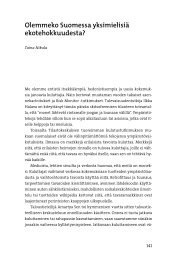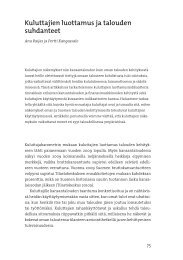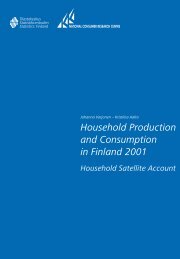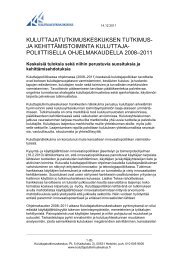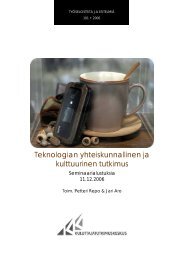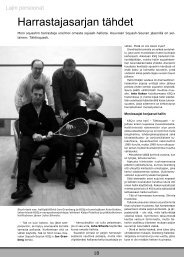Household Production and Consumption in Finland 2001
Household Production and Consumption in Finland 2001
Household Production and Consumption in Finland 2001
You also want an ePaper? Increase the reach of your titles
YUMPU automatically turns print PDFs into web optimized ePapers that Google loves.
however, it is always open to criticism because there is no such th<strong>in</strong>g as a<br />
“correct” equivalent market wage. The comb<strong>in</strong>ed use of the <strong>in</strong>put <strong>and</strong> output<br />
methods, whereby the mixed <strong>in</strong>come obta<strong>in</strong>ed by the output method is<br />
divided by the number of hours spent <strong>in</strong> work, yields a reference hourly wage.<br />
The team that compiled the UK <strong>Household</strong> Account <strong>in</strong> 2000 was <strong>in</strong> the<br />
position to use this approach. The results show that this “hourly wage” varies<br />
widely from one task-group to another. For comparative purpose it is<br />
important to take careful stock of which items are <strong>in</strong>cluded <strong>in</strong> <strong>in</strong>termediate<br />
consumption <strong>in</strong> each of the methods because <strong>in</strong> the output method, the value<br />
of <strong>in</strong>termediate consumption goods <strong>and</strong> services has a direct bear<strong>in</strong>g on value<br />
added. Kristi<strong>in</strong>a Aalto has calculated hourly wages for laundry washed at home<br />
on the basis of the number of kilogrammes of laundry <strong>and</strong> the cost of<br />
professional laundry services (Varjonen & Aalto 2005). The results show that<br />
the hourly wage is higher than when calculated on the basis of <strong>in</strong>puts. Do<strong>in</strong>g<br />
the laundry is a task that can be done <strong>in</strong> households with quite considerable<br />
efficiency us<strong>in</strong>g automatic wash<strong>in</strong>g mach<strong>in</strong>es. Therefore it will not easily move<br />
to the market sector.<br />
In this Satellite Account hous<strong>in</strong>g has been approached as a s<strong>in</strong>gle entity,<br />
without dist<strong>in</strong>guish<strong>in</strong>g between space used for unpaid work <strong>and</strong> leisure<br />
activities or sleep<strong>in</strong>g. When the output method is used, this entity must be<br />
divided <strong>in</strong>to different parts because the price of the market commodity<br />
correspond<strong>in</strong>g to the output also <strong>in</strong>cludes facilities, e.g. meals consumed <strong>in</strong> a<br />
restaurant <strong>in</strong>clude kitchen <strong>and</strong> d<strong>in</strong><strong>in</strong>g area costs. In the future leisure activities<br />
could be <strong>in</strong>cluded as an extension to the Satellite Account. Then, liv<strong>in</strong>g spaces<br />
<strong>in</strong> leisure use could also be allocated to their own pr<strong>in</strong>cipal function, as could<br />
acquisitions, travel etc. <strong>in</strong>tended for leisure activities. That would help to<br />
complement the picture of economic activities <strong>in</strong> households with respect to<br />
leisure production <strong>and</strong> consumption.<br />
74 Statistics F<strong>in</strong>l<strong>and</strong> National Consumer Research Centre




